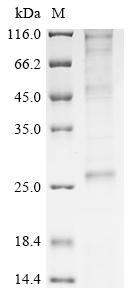Recombinant Mouse Voltage-dependent calcium channel gamma-1 subunit (Cacng1) gets produced through an E.coli-based cell-free expression system, which appears to deliver efficient synthesis. This full-length protein spans 223 amino acids and comes with an N-terminal 10xHis-tag that makes purification and detection more straightforward. SDS-PAGE analysis confirms purity levels exceeding 85%. The protein contains a 4TM transmembrane domain and is supplied through a detergent platform - a setup that likely helps maintain both stability and functionality.
The Voltage-dependent calcium channel gamma-1 subunit (Cacng1) seems to play a vital role in how calcium channels operate. It's closely tied to controlling calcium ion movement across cell membranes, which influences a range of biological processes. Understanding this protein may be crucial for calcium channel regulation research and could prove valuable for scientists working on ion channels and related pathways.
Potential Applications
Note: The applications listed below are based on what we know about this protein's biological functions, published research, and experience from experts in the field. However, we haven't fully tested all of these applications ourselves yet. We'd recommend running some preliminary tests first to make sure they work for your specific research goals.
The mouse Cacng1 is a membrane protein with 4 transmembrane domains that requires proper integration into a lipid bilayer and correct folding for its function as a voltage-dependent calcium channel subunit. While cell-free systems can improve solubility for membrane proteins compared to traditional E. coli expression, they still lack the native membrane environment necessary for proper folding of multi-pass transmembrane proteins. The detergent used for solubilization may not replicate the natural lipid bilayer, potentially leading to non-native conformations. Without experimental validation (e.g., circular dichroism for secondary structure or functional assays), the protein cannot be assumed to be correctly folded or bioactive.
1. Membrane Protein Biochemical Characterization Studies
This application is feasible for basic biophysical characterization of the detergent-solubilized protein (e.g., stability in different detergents, aggregation state). However, the data will reflect the properties of the protein in detergent micelles, which may differ significantly from its native membrane-embedded conformation. Avoid extrapolating to in vivo structure-function relationships without validation.
2. Antibody Development and Validation
This application is suitable. The recombinant Cacng1 can serve as an immunogen for antibody production against linear epitopes, even if misfolded. The high purity supports consistent immunization. However, antibodies generated may not recognize conformational epitopes of native, membrane-embedded Cacng1. Validate antibody specificity against full-length Cacng1 expressed in mammalian cells.
3. Protein-Protein Interaction Screening
Use with caution. The His-tag enables pull-down assays, but if Cacng1 is misfolded, interactions may be non-physiological. Membrane proteins typically require their native lipid environment for correct interaction interfaces. Validate any identified partners using full-length Cacng1 in membrane preparations or cellular systems.
4. Comparative Species Analysis
This recombinant mouse Cacng1 is suitable for sequence-based comparisons or basic biochemical properties. However, for functional comparisons (e.g., binding affinity, channel modulation), the protein must be properly folded and integrated into a membrane. Without activity validation, functional insights are unreliable.
Final Recommendation & Action Plan
Before using this recombinant Cacng1 for functional studies, validate its folding and membrane integration. First, analyze secondary structure via circular dichroism and check oligomerization state via size-exclusion chromatography. If possible, incorporate the protein into liposomes and test its ability to interact with other calcium channel subunits. For antibody production, proceed but validate antibodies against native Cacng1. Avoid functional interaction studies without confirmation of native-like structure. For reliable results, consider expressing Cacng1 in mammalian cells that can provide the proper membrane environment.






